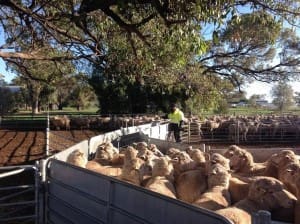
NSW DPI livestock handler Tom Patterson, drafts CTSE progeny from the 2013 drop at the Trangie Agricultural Research Centre.
Merino breeders will get insights into the value of early measurement of wool production traits at a free Trangie field day this month.
DPI sheep researcher Sue Mortimer said new information from a post-weaning fleece assessment project funded by Australian Wool Innovation will be outlined at the June 18 field day at the Trangie Agricultural Research Centre.
The early-age fleece trait project is looking at post-weaning fleece traits, their inheritance and their relationship with later performance in Merino sheep.
“We’re looking at wool production characters; in terms of fleece weight, greasy and clean, yield, diameter, co-efficient of variation of diameter, staple length and strength.
“We have information on wool production traits at yearling, hogget and adult ages, but increasingly the recording and evaluation of rams is occurring at early ages,” she said.
Dr Mortimer said the measurements are being taken on ewes and wethers, additional to what was needed for the Macquarie Central Test Sire Evaluation conducted with the support of the Australian Merino Sire Evaluation Association at Trangie.
“We just added two additional shearings – a post-weaning (8.5 months) to the hogget (15 months) shearing planned for this site plus the adult shearing at 22 months of age.”
Early results on fleece weight heritability
She said the data is being analysed, but early results do suggest that for fleece weight at least, the heritability may be lower than the estimates currently used for yearling expression.
“For the other traits, the heritability seems to be consistent with the estimates for yearling expression,” she said.
Dr Mortimer said if data from a post-weaning or hogget shearing or even as a yearling, is the only information a flock owner is able to get, it will be useful for selection purposes.
“It will be useful information, although its relationship with traits expressed later on may not be as strong.
“There will still be value in having that information, because without it your accuracy in identifying animals of greater genetic merit will be reduced.”
Early measurement still reasonable predictor
Earlier measurement would still be a reasonable predictor of performance later in life, she said, though results from various studies show that one measurement as an adult also would be needed to have more accurate predictions of lifetime wool production. Then accuracy of selection of rams and ewes is much improved by having the extra measurement with the early assessments, Dr Mortimer said.
“The data is a start in the direction of determining how different bloodlines might perform at an early age.
“We would certainly need greater numbers of sires representing each of the bloodlines to get good information in that respect.”
Latest Merino sire evaluations will be available
The latest results from Merino sire evaluations will be available at the field day. Producers will be able to inspect 27 progeny groups from the 2013 drop and learn how to use Central Test Sire Evaluation (CTSE) reports to add value to their flocks.
Independently evaluated in the Macquarie Valley by the Department of Primary Industries (DPI), the CTSE reports provide benchmarks for Merino sire performance from leading Merino studs, including seven local studs, in low rainfall, mixed farming and pastoral environments.
Dr Mortimer said sire evaluations deliver reliable information on commercially significant wool and meat traits to producers who want to meet flock breeding objectives.
“Evaluations of the 2012 and 2013 progeny of 23 elite Merino rams, including Dohne Merino and soft rolling skin (SRS) sires, contain visual and measured assessments of wool production and quality, growth rates and ultrasound eye muscle and fat depth of the progeny,” Dr Mortimer said.
“Breeding programs based on artificial insemination can link visual traits to performance using sire evaluation quality performance records on critical visual traits.”
Practical demonstrations of sheep handling equipment
Local wool classers, ram breeders and industry specialists will be available to answer questions, discuss options and explain how breeding objectives can be best met.
Producers will also be given practical information and demonstrations on getting value from sheep handling equipment. Information on Australian Sheep Breeding Values, visually assessed production traits and flock breeding values http://merinosuperiorsires.com.au/ is available for the sires.
The Merino CTSE field day, sponsored by Sheep Connect NSW, will run from 10am until 4pm with lunch provided by the Trangie CWA.
Contact Toni George at TARC to register for the field day, [email protected] and (02) 6880 8043.
Source: NSW DPI



HAVE YOUR SAY